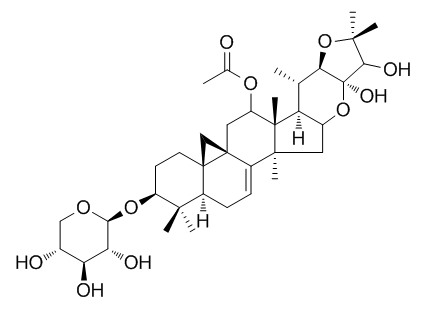Cimiracemoside F
Cimiracemoside F has anti-stress effects.
Inquire / Order:
manager@chemfaces.com
Technical Inquiries:
service@chemfaces.com
Tel:
+86-27-84237783
Fax:
+86-27-84254680
Address:
1 Building, No. 83, CheCheng Rd., Wuhan Economic and Technological Development Zone, Wuhan, Hubei 430056, PRC
Providing storage is as stated on the product vial and the vial is kept tightly sealed, the product can be stored for up to
24 months(2-8C).
Wherever possible, you should prepare and use solutions on the same day. However, if you need to make up stock solutions in advance, we recommend that you store the solution as aliquots in tightly sealed vials at -20C. Generally, these will be useable for up to two weeks. Before use, and prior to opening the vial we recommend that you allow your product to equilibrate to room temperature for at least 1 hour.
Need more advice on solubility, usage and handling? Please email to: service@chemfaces.com
The packaging of the product may have turned upside down during transportation, resulting in the natural compounds adhering to the neck or cap of the vial. take the vial out of its packaging and gently shake to let the compounds fall to the bottom of the vial. for liquid products, centrifuge at 200-500 RPM to gather the liquid at the bottom of the vial. try to avoid loss or contamination during handling.
J. Soc. Cosmet. Sci. Korea2021, 47(1):57-63
Reprod Sci.2022,10.1007/s43032-022-01117-4.
J Korean Soc Food Sci Nutr2023, 52(11):1101-1110
Current Topics in Nutraceutical Research2021, 19(1),p90-105.
Mol Pharm.2017, 14(9):3164-3177
J Biomol Struct Dyn.2023, 1-21.
Molecules.2023, 28(13):4971.
Antioxidants (Basel).2021, 10(9):1487.
J Ginseng Res.2022, 46(1):104-114.
Heliyon.2023, 9(11):e21944.
Related and Featured Products
Phytochemical Analysis, 2011, 22(4):339-351.
Phytochemical fingerprinting to thwart black cohosh adulteration: a 15 Actaea species analysis.[Reference:
WebLink]
The popular use of black cohosh products (Actaea racemosa L., syn. Cimicifuga racemosa L.) is growing as the demand for alternatives to estrogen therapy has increased. Critical to safe use is the assurance of unadulterated, high-quality products. Questions have been raised about the safety of black cohosh due to cases of liver toxicity in patients who reported taking it; subsequent evaluation found some products to be adulterated with other related herbal species. Correct plant species identification is a key first step for good manufacturing practices of safe black cohosh products. OBJECTIVES: To develop analytical methods which distinguish black cohosh from other species (American and Asian) of Actaea increasingly found as adulterants in commercially available black cohosh products.
METHODS AND RESULTS:
Fifteen species of Actaea were collected from North America and Asia, and the phytochemical fingerprints of these samples were established using HPLC-PDA and LC-MS techniques. The HPLC and LC-MS fingerprints for polyphenols and triterpene glycosides revealed distinct patterns that make black cohosh clearly distinguishable from most other species of Actaea. Two marker compounds, cimifugin and Cimiracemoside F, were found to be important to distinguish black cohosh from most Asian species of Actaea. Formononetin was not found from either Asian or American species of Actaea.
CONCLUSIONS:
Phytochemical fingerprinting is a practical, reliable method for authenticating black cohosh and distinguishing it from other species of Actaea increasingly found as adulterants in commercially available black cohosh products. This should facilitate the continued development of high-quality, unadulterated black cohosh products.



